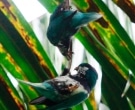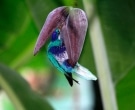Content |
|---|
Description
The Ultramarine Lorikeet (Vini ultramarina) has a length of 18 cm.. and an approximate weight of 35 g..
Forehead bright navy blue iridescent; crown and nape Mallow dark blue with streaks of light blue; lores and spots on ear-coverts, white (bases of ear-coverts, purple and blue color). Mantle and covert wing, Navy blue; rump and tail coverts, dark blue light. The flight feather, light blue, blackish internal. Blue off the Underwing coverts. Throat dark blue with white speckles; in the band chest mauve blue with área subterminal pale blue feathers. Belly blank slate bases in feathers, giving a mottled appearance; the thighs dark blue malva; coverts, Turquoise.
The uppertail-coverts, whitish blue with navy blue light diffuse in the outer margins;
undertail coverts whitish merged with navy and some irregular gray markings.
Bill yellow orange, upper jaw, blackish brown at the base; irises brownish yellow; the orange legs.
Both sexes are equal but the female It is slightly smaller.
The immature adult differ by the absence of white on underparts, they are uniformly blackish. Also by bill black, irises Dark Brown and legs orange-brown.
- Sound of the Ultramarine Lorikeet.
Habitat:
In the Decade of 1970 in Nuku Hiva, these parrots were found only in pristine forests (that they have not been touched and that it is in its original condition) on the 700 m.
There is a similar habitat preferences in UA Pu, where are located mainly in montane forests between 700 and 1.000 m. Populations have also been of Ultramarine Lorikeet in banana plantations, coconut and mango (Mangifera indica), in coastal areas.
The species seems to have a wider range of habitat preferences in UA Pu., being found at altitudes ranging from the coast to wooded crests.
They feed in trees with flowers, especially coconut trees and Erythrina.
Loud and lively; the birds move freely between the canopy and lower floors, allowing the human approach. They usually travel in pairs or groups of up to a dozen of individuals. Most of its flights are made below the level of the trees, but for longer distances they rise spiral up to considerable heights.
Extremely Active, rarely long they stay in a tree and feeds using the peak acrobaticamente support.
Reproduction:
The nesting of these birds is from June to August.
It nests in hollow trees, preferring Artocarpus altilis, Pometia, Pandanus tectorius and Hibiscus tileacus. Sometimes they use the old nest of another species. They lay two white eggs.
A captive breeding record gives the chick eight weeks to become independent.
Food:
It feeds on a great variety of trees in flower, nectar and pollen. Within your preferences are the flowers of the coconut palm, the native tree and banana Hibiscus tileaceus.
It also feeds on fruits, especially mango and insects.
Distribution:
Size of its range (reproduction / resident): 100 km2
The Ultramarine Lorikeet is endemic of the Marquesas Islands, of Nuku Hiva, UA Pu and UA Huka, Although fossil remains show that previously most widely spread.
In UA Pu the population was estimated at 250-300 couples in 1975. But in 1988 had shrunk around the 60%, probably due to the spread of rats Rattus rattus, and a hurricane in 1988, Although its effects on the population of birds are uncertain.
In Nuku Hiva the small population of around of 70 birds that inhabited the high valleys and ridges in the northwestern part of the island, between 700 and 1.000 d., You can that they are now extinct.
The majority of the population, to this day, remains in UA Huka, where the species was introduced in 1940. This population would have grown from 200 to 250 couples in the late 1970s and was considered abundant in 1990 at altitudes environment to the 500 d., with a population estimated between 1.000 and 1.500 birds. The main threat to the species, here, is the potential arrival of rats, and between 1993 and 1994, 14 Ultramarine Lorikeet they were moved to Fatu Hiva in an attempt to keep them safe from rats; But, habitat deterioration by grazing mammals and avian malaria, also they have been and are still potential factors to increase the vulnerability of this species.
Conservation:
• Current IUCN Red List category: Danger.
• Population trend: Decreasing.
CITES Appendix I. in danger of extinction.
The entire population is located on an island where the species is stable, in other islands recently has been extinguished. The general trend is suspected to be a slow and continuous decrease. If the black rats come to UA Huka the decrease will be quick and severe.
Other threats included are logging in some sectors of the habitat of the Ultramarine Lorikeet to plant crops, fruit trees, and use the trunks for woodcarvings for tourism.
"Ultramarine Lorikeet" in captivity:
Extremely rare.
Alternative names:
– Ultramarine Lorikeet, Marquesas Lorikeet, Ultramarine Lory (ingles).
– Lori ultramarin, Lori de Goupil, Lori des Marquises (French).
– Ultramarinlori (German).
– Loris Vini Ultramarine (Portuguese).
– Lori Ultramar, Lori Ultramarino (español).
scientific classification:
– Order: Psittaciformes
– Family: Psittaculidae
– Scientific name: Vini ultramarina
– Citation: (Kuhl, 1820)
– Protonimo: Psittacus ultramarinus
Images “Ultramarine Lorikeet”:
Videos "Ultramarine Lorikeet"
————————————————————————————————
“Ultramarine Lorikeet” (Vini ultramarina)
Sources:
– Avibase
– Parrots of the World – Forshaw Joseph M
– Parrots A Guide to the Parrots of the World – Tony Juniper & Mike Parr
– Birdlife
– Photos:
1 – Miles to the wild – link
2 – Miles to the wild – link
3 – Miles to the wild – link
4 – An adult bird perched on a palm tree – Author Josep del Hoyo – IBC.lynxeds.com
5- A juvenile bird feeding in a tree. – Author Josep del Hoyo – IBC.lynxeds.com
– Sounds: Mark Todd (Xeno-canto)






